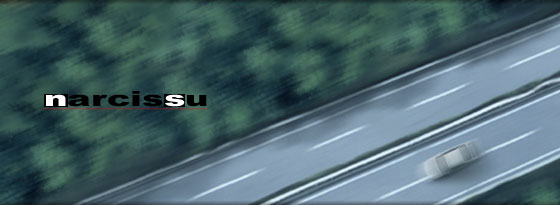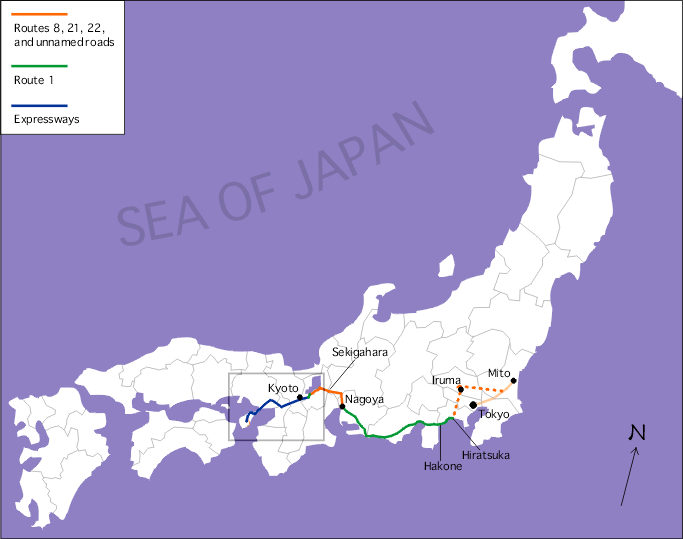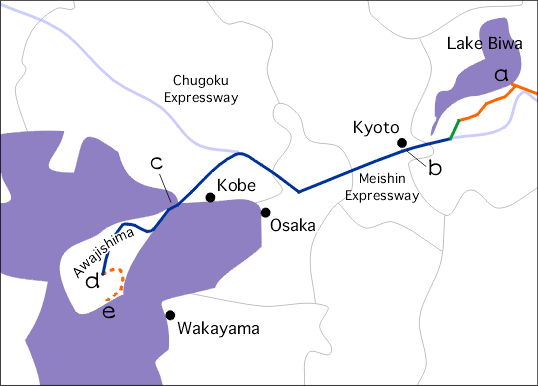 |
 |
|
World
Seen from so close, Awajishima divides the sea between Suma and Akashi in two: the scene rivals those of Wu and south-east Chu of which the poet Du Fu speaks. Those who know much of the world will surely be reminded of many such sights.
- Matsuo Basho and Kawai Otokuni, "Oi No Kobumi"
A Word Of Warning
If you do not wish to be spoiled on certain details of the piece, it would be best for you not to read this document until you have finished reading Narcissu at least once.
The Hospital
The hospital at which the characters meet is entirely fictional. It is located in some deliberately unspecified town in Ibaraki prefecture (north-east of Tokyo).
The Escape
Americans and Canadians: remember that the Japanese, like the citizens of all truly enlightened nations, drive on the left.
The early stages of the journey are unclear to readers and protagonist alike. They escape on January 19th, and that evening a title card reveals them to be in Ibaraki prefecture on the Mito Highway, which is the name of the stretch of Route 6 between Tokyo and Mito. We can draw few conclusions from this, since we don't know which direction they're travelling at the time.
The first location that is unambiguously named is Iruma in Saitama prefecture. They seem to approach this city travelling east, although it is far to the west of Route 6, which implies that they have indeed been wandering to the extent the narration suggests.
From Iruma, it is suggested that they turn onto Route 16 (which is a ringroad around Tokyo) and travel south via Hachiouji. Whatever the case, the pair clearly travel roughly south and hit the coast. We then lose them again, as they drive round Kanagawa prefecture for four days, filling up twice and committing various petty crimes.
It is after this that their route becomes somewhat easier to follow. A rough map:

Route 1
National Highway Route 1 is the old major road from Tokyo to Osaka, now largely superceded by a pair of motorways, the Tomei Expressway (Tokyo-Nagoya) and the Meishin Expressway (Nagoya-Kobe via Osaka). Its history is long and illustrious: it follows the route of the Tokaido, the 17th-century road linking the Tokugawa capital at Edo (modern Tokyo) with the old Imperial capital of Kyoto. The place of the Tokaido in the Japanese consciousness can be compared with that of Route 66 in American minds. It starts at Tokyo's Nihonbashi, and proceeds south and west around the coast.
Our heroes join Route 1 at Hiratsuka, the seventh of the 53 traditional stops on the Tokaido. From here they drive west to Nagoya. At Nagoya, however, they leave Route 1 again, and with it the Tokaido, and take a diversion to the north instead. Apparently this is the scenic route.
Digressions
The itinerary between Hiratsuka and Nagoya contains an unexpected omission - Mount Fuji. They pass within 20 km of Japan's most famous sight, and yet this section of the journey is not described at all. Maybe a Japanese reader would automatically insert his or her own reference without needing prompting.
As they whiz through the snowy hills northwest of Nagoya, you may notice Setsumi dropping the name "Sekigahara". The significance of this town in Japanese history is that a battle fought there about 400 years ago cemented the rise to power of the Tokugawa shogunate. The name has a certain significance in Narcissu too - it's the first point at which we discover that Setsumi's knowledge has any limits. It's fairly difficult to draw an adequate analogy between this and a bloody event best known for half the generals changing sides when they realised they weren't winning, but I'm sure a sufficiently desperate literature student would gladly attempt it. Luckily for you, I graduated years ago.
The Closing Stages
Here we pass onto a more detailed map:

The location of the second beach scene [a] is Lake Biwa. This is Japan's largest and most famous lake, and a significant cultural location, being so close to the old Imperial capital. The poet Basho, whose description of Awajishima is quoted above, also lived on its shores for some time.
After this, our heroes finally join the Meishin Expressway. Japanese expressways are toll roads, and not particularly cheap; the current toll for the 47 km section of the Meishin they cover, for example, is 1,550 yen (about £7.80, or 15 US dollars). They only cover about half that distance today, however, before reaching Katsuragawa Parking Area [b] (parking areas are small service stations, providing mainly rest facilities rather than a fuller service, although Katsuragawa does also have a small shop and a snack bar), events subsequent to which lead to a dash into an unnamed urban centre - presumably Kyoto.
From this point Setsumi finally settles down and comes up with a direct route, skirting Kobe and finally arriving at the Akashi-Kaikyo Bridge [c]. This is the easternmost of three road links between the islands of Honshu and Shikoku (you may have noticed the protagonist mistakenly name another of them earlier), and since opening in 1998 has been the main connection to the island where this journey ends. As one of the world's largest bridges, the Akashi-Kaikyo Bridge is indeed a popular spot for photography, though most visitors content themselves with pictures of rather than from it.
Awajishima
Awajishima is one of the many minor islands of the Japanese archipelago, being approximately the same size as the Isle of Man; it is located in the Seto Inland Sea, between Kobe on the mainland and the major island of Shikoku. The hilly northern part of the island is taken up by a series of towns currently administered together as Awaji City; the central part is taken up by the larger city of Sumoto; and the southern area is divided between Minami-Awaji City in the level west, and a sparsely populated mountainous region along the south coast. It is in this last region that the narcissi bloom.
Setsumi and the protagonist leave the expressway at Sumoto Interchange [d] and head south. The precise route taken is unclear; there are some very minor roads that cross the mountains directly, but it's likely that they take the coast road instead. Their ultimate destination is somewhere in the vicinity of Nadakuroiwa Narcissus Field [e]. Nadakuroiwa itself has limited opening hours and an entry fee, but there are apparently many similar sites along the coast.
From the narcissi, of course, there is only one more journey for either character to make... and it is not one that can be illustrated on any map.
19 August 2005
Peter Jolly
Hæleþes áwendende